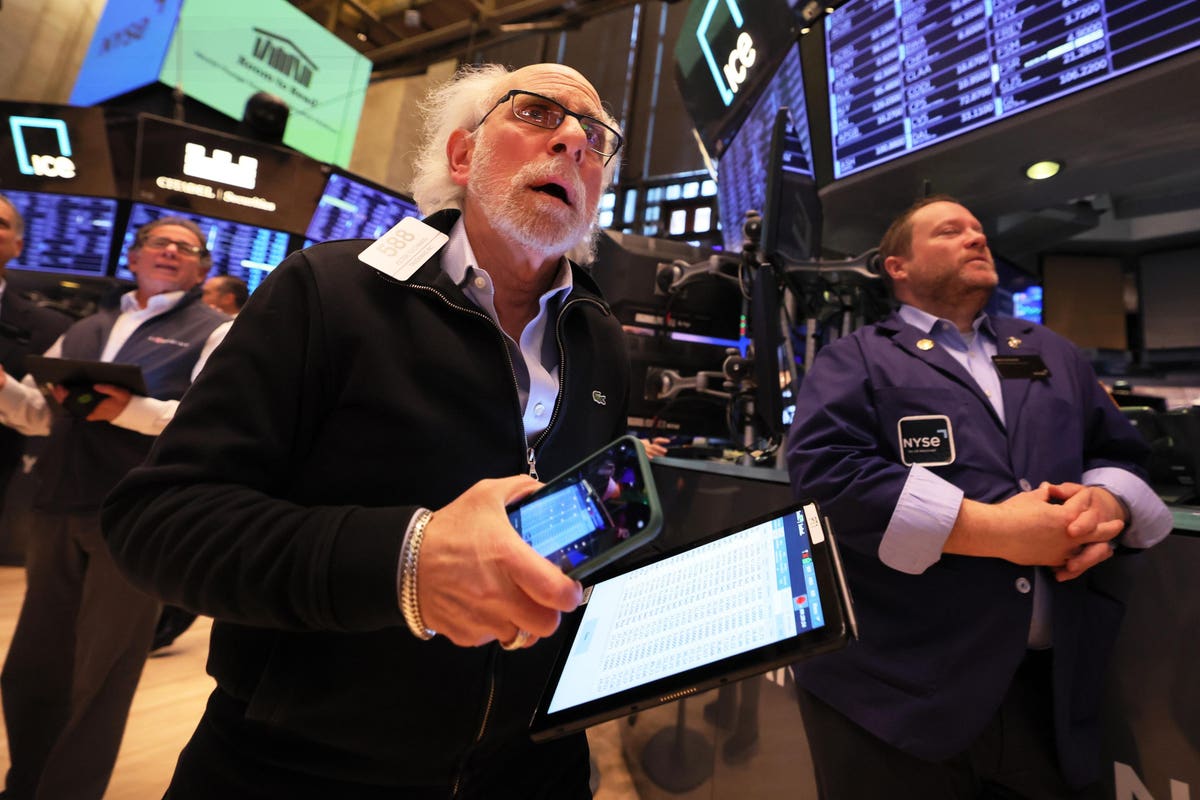The U.S. Federal Reserve’s own internal forecasts and the inverted yield curve both suggest the U.S. could hit recession soon. However, other indicators, especially the jobs market, are more upbeat. Here’s what the latest economic data suggests.
Recession Omens
Several indicators calling for a recession have relatively robust track records. Still we haven’t seen a recession yet.
The Yield Curve
The inverted yield curve, has among the best track records in calling recessions, though perhaps its strong forecasting streak could end. It currently signals a very high chance of recession on a 12-month view. Specifically, a model that the New York Federal Reserve maintains, gives an almost 70% chance of recession, which is elevated compared to history.
The reason why is because the U.S. Treasury yield curve is strongly inverted. 10-year U.S. government bonds currently yield over 1.5% less than 3-month bills. We haven’t see such a large negative spread since the early 1980s. Remember that 1980, 1981 and 1982 were all years that saw recessions.
Fed Projections
It is also notable that the base case of the Fed’s own economists is that the U.S. sees a recession in 2023, though we may be running out of time for that to play out, as in the first half of 2023, U.S. GDP appears to have grown according to nowcast data from the Atlanta Federal reserve and economists’ estimates.
The Housing Market
House prices has slowed in 2023 and fallen year-on-year in April 2023 according Case-Shiller National House Price data. However, the overall housing picture is nuanced. Prices are falling on the west coast, but holding up better in other regions.
Plus housing activity, as measured by housing permits has slowed, but has fared better than many expected, with the stock prices of many U.S. homebuilders rallying strongly year-to-date.
Housing matters for growth because although it’s a fairly small part of the economy, very large swings in activity, which are common to the housing market. can be enough to help force the U.S. economy into recession. Currently we haven’t seen that, though it remains a risk.
Also, housing affordability remains a drag on demand. The sharp spike in interest rates has doubled mortgage costs. The cost of a 30-year mortgage is up from around 3% in 2021 to almost 7% today. That increase in the cost of servicing a home purchase creates a clear headwind for many buyers.
Student Loan and Budget Headwinds
As we enter the second half of 2023, there are a couple of potential economic shocks that could slow growth. The first is the anticipated resumption of student loan payments, this expenditure could reduce expenditure on other goods and services. Second the prospect of a government shutdown could also slow economic growth, if politicians are unable to agree on a budget. Also, internationally, China’s economic reopening after the pandemic hasn’t generated the economic tailwind that many anticipated, at least so far. These factors appears likely to cause a recession in isolation, but they could tip a sluggish economy into recession. Also economic history also teaches us that many economic shocks come along that are not forecasted in advance, so we’ll have to see what the remainder of 2023 holds.
Positive Signs
However, there are always risks to the economy and there are quite a few positive signs that have helped the U.S. economy and provide more grounds for optimism.
Favorable Employment Data
One main driver of a strong U.S. economy in 2023 is robust employment. Jobs have held up better than expected, and even though various large companies have made layoffs in 2023, jobs have continued to grow with unemployment remaining close to historically low levels. That could change quite rapidly, but for now it has not as the U.S. economy continues to add jobs, especially in the services sector. That said, the rate of job growth appears to be slowing as of the most recent jobs report for June, but has not yet slowed sufficiently to risk a recession.
Slowing Headline Inflation
The Fed is committed to high rates until inflation cools. The Fed isn’t satisfied yet, and a further rate hike could come this July, but nonetheless headline inflation is coming down. Yes, inflation isn’t beaten, but the picture could have been a lot worse if inflation hadn’t at least levelled out on core measures. That has encouraged fixed income markets to speculate that the Fed could consider cutting rates in 2024. If that were to occur, that could help spur growth. However, the Fed is not willing to speculate on rate cuts yet and there remains a disconnect between the Fed and markets on a medium-term rate outlook.
Contained Banking Issues
There was concern that banking failures earlier in 2023 could broaden and that banks would curtail lending as a result. So far we haven’t seen those more pessimistic forecasts play out, which has prevented what could have been a material headwind to the economy.
A Positive Stock Market
One leading indicator of the U.S. economy is stock prices, despite their volatility. At this point the S&P 500 is up over 15% for 2023 so far, suggesting some optimism on the economy. Of course, markets may be looking through a recession to the Fed cutting rates in response. Nonetheless, the markets appear more upbeat than earlier in the year, and reduced recession probabilities could be playing into that.
The Verdict
Ultimately, just because a recession hasn’t happened yet, doesn’t mean it won’t occur, but the economy has held up better in 2023 so far than many expected. The U.S. economy continuing to add jobs has helped the U.S. dodge a recession so far, and so the health of the jobs market should be watched closely.
Still the clock is ticking on a 2023 recession forecast as any recession would have to start soon and for the first half of the year, employment data has held up well. That said, looking further out many robust indicators are suggesting that the U.S. economy would be doing well to avoid a recession in 2024, especially if the Fed decides to continue to nudge up rates further in 2023 as they have signaled is quite possible.
Read the full article here













